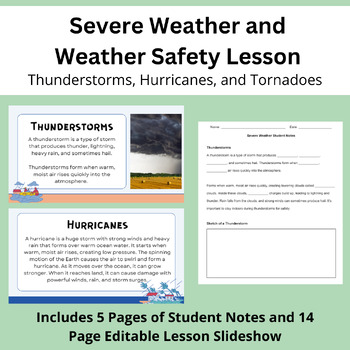Severe Weather and Safety Lesson | Thunderstorms, Hurricanes, and Tornadoes
The Lab Station
4 Followers
Grade Levels
4th - 8th
Subjects
Resource Type
Standards
NGSS5-ESS2-1
NGSSMS-ESS2-5
Formats Included
- Google Drive™ folder
The Lab Station
4 Followers

Made for Google Drive™
This resource can be used by students on Google Drive or Google Classroom. To access this resource, you’ll need to allow TPT to add it to your Google Drive. See our FAQ and Privacy Policy for more information.
Description
This lesson is a perfect way to review the key types and causes of the main types of severe weather: thunderstorms, hurricanes, storm surges, lightning, thunder, and tornadoes. The lesson includes how each type of severe weather forms, examples, and key weather safety tips for each.
This download includes a 14-page slideshow which is editable in Google Slides and has a PDF version. There are also two versions of the guided student notes that pair perfectly with the lesson presentation.
Thank you so much for your download. Please don't hesitate to reach out if you have questions.
Looking for another lab for your science class? Check out some of these additional labs:
- Plate Tectonic Graham Cracker Lab
- Modeling the Moon Phases Oreo Cookie Lab
- Physical and Chemical Weathering with M&Ms
- Earth's Spheres Graphic Organizer and Lesson
- Smores Solar Oven Lab
- Weathering, Erosion, and Deposition Digital Assessment
- The Rock Cycle: Weathering, Erosion, and Deposition Science Lesson
Total Pages
Answer Key
N/A
Teaching Duration
N/A
Report this resource to TPT
Reported resources will be reviewed by our team. Report this resource to let us know if this resource violates TPT’s content guidelines.
Standards
to see state-specific standards (only available in the US).
NGSS5-ESS2-1
Develop a model using an example to describe ways the geosphere, biosphere, hydrosphere, and/or atmosphere interact. Examples could include the influence of the ocean on ecosystems, landform shape, and climate; the influence of the atmosphere on landforms and ecosystems through weather and climate; and the influence of mountain ranges on winds and clouds in the atmosphere. The geosphere, hydrosphere, atmosphere, and biosphere are each a system. Assessment is limited to the interactions of two systems at a time.
NGSSMS-ESS2-5
Collect data to provide evidence for how the motions and complex interactions of air masses result in changes in weather conditions. Emphasis is on how air masses flow from regions of high pressure to low pressure, causing weather (defined by temperature, pressure, humidity, precipitation, and wind) at a fixed location to change over time, and how sudden changes in weather can result when different air masses collide. Emphasis is on how weather can be predicted within probabilistic ranges. Examples of data can be provided to students (such as weather maps, diagrams, and visualizations) or obtained through laboratory experiments (such as with condensation). Assessment does not include recalling the names of cloud types or weather symbols used on weather maps or the reported diagrams from weather stations.



